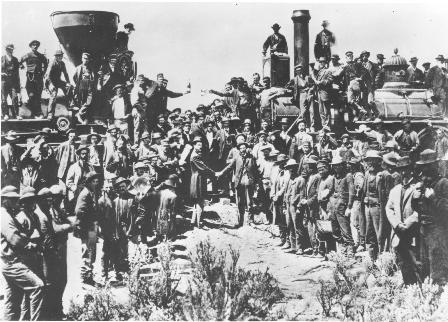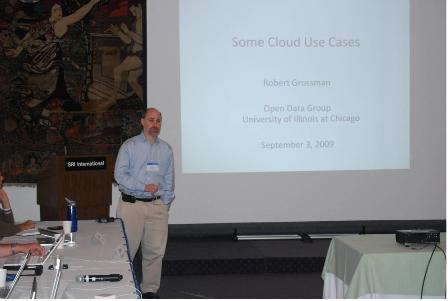This is a cross-post of a blog article written by Gregory Ness, former VP of Marketing for Blue Lane Technologies who is currently working for InfoBlox.
It only makes sense that the steam locomotive existed before the completion of the Transcontinental Railroad. One breakthrough created the need for another. The power of the VM (virtual machine) introduced unprecedented mobility and flexibility, albeit within the confines of a VLAN container. That mobility and flexibility has created new demands for larger, unified and intelligent network infrastructures or infrastructure 2.0.
An Historical Perspective on Network Innovation
The steam engine, the locomotive and the rail are perfect examples of synergistic developments. Greater speed and mobility pushed the limits of infrastructure and created a compelling case for longer stretches of track. More cities became connected by rail lines over time, and soon even towns sprang up “in the middle of nowhere” along the tracks.
The increasing reach of the railroad opened up massive opportunities for development and trade and helped to forge national identities. From towns to industries the railroad shifted competitive advantage based on the sheer power and influence of transport and created massive wealth redistribution.
Today’s technology leaders, especially in the network and server and virtualization space (like Cisco, HP, VMware and others) will achieve strategic advantage if they get the spike before their competitors. Let me explain as we glimpse back at a strategic moment in US history defined by a spike of gold.
The Golden Spike Ceremony: 1869
Thanks to Wikipedia for the photo.
Virtualization’s virtual machine is pushing the limits of today’s static networks just as the steam locomotive drove the construction of iron rails to connect the coasts.
Perhaps today, like those who think that virtualization ends with the VLAN, there were some who didn’t understand the need for a rail system to connect both coasts.
Full VMotion is Virtualization’s Golden Spike
Yet the questions we ask today regarding our static, manually managed networks need to be answered before we can fulfill the full potential of VMotion. Many of the questions may ultimately be answered by the newly formed infrastructure 2.0 working group.
Addressing and automation are core issues; solving them will deliver new potentials in security, application delivery and disaster avoidance/recovery and create entirely new IT business models and applications. They will also help to minimize the impact of the necessary complexity that VMware’s Thiele talks about in his latest blog:
The network is a great example of “hidden” complexity. Today the average network administrator can plug in a switch to another switch and then plug devices into the new switch and expect that in most cases the network will work. Imagine if before he could get the server to talk to the switch he had to create a new address from scratch or spell out the switch port in the server’s network interface card. The fact is networks have been hiding complexity for years, but they still have a long way to go. When you can log into a console and use your mouse pointer to drag a server into a network or resource pool and have the appropriate network security and routing policies applied, you’ll be getting close to IT nirvana. Although you might disappoint the hardcore network administrator who was hoping to spend some late nights and weekends tweaking the environment.
(Mark Thiele, VMware, “Complexity in IT Systems…” Sep 17, 2009)
Ironically, Bob Grossman, who is considered to be one of the fathers of cloud computing, kicked off the infrastructure 2.0 working group with a preso highlighting a train at the Russian/Chinese border undergoing a manual gauge change. Talk about a “tin spike” connecting the two systems; each train is lifted by a team of laborers so that the undercarriage can be adjusted for a different sized track.
Bob has been building clouds (multi-site grids of computing power) for decades. His understudy, Stuart Bailey, founded Infoblox (my employer).
Bob Grossman Briefing the Infrastructure 2.0 Work Group
Yet rail systems are incredibly linear, especially in those days. Today’s networks are more like pulsing meshes. So if a VM takes off from one VLAN for another determining its location (security, delivery, management policies require foreknowledge of the VM’s location) is strategic to a stateful trip. If you can preserve the state (security, etc) of the VM while it moves great distances you deliver the golden spike, full VMotion.
That spike is strategic to the fortunes of networking vendors, cloud providers and enterprises because it enables new levels of flexibility, scale, automation and security across data centers, transforming the economics of IT, in the same way that the Transcontinental Railroad helped to unify a nation and create new towns and cities, and grow established ones.
Railroads were a critical fabric for the industrial revolution and the global emergence of nationalism. Networks are the critical and often overlooked fabric for the most powerful form of cloud computing the next stage of the computer revolution, sometimes called the intercloud.
This makes addressing strategic to the golden spike. That was one of the critical cloud problems discovered decades ago when the University of Illinois (Bob Grossman’s team) switched from circuit to packet switched networks and inspired Stu to launch Infoblox. And that brings us back to the dust covered worlds of DNS, DHCP and IP address management automation and an emerging technology called IF-MAP.
When this golden spike is driven into the network it will enable a new generation of cloud operating systems layered on top of sophisticated cloud positioning systems with real-time intelligence on systems, location, policy, etc. We’ll see hyper-efficient and intelligent networks that are as fast and up-to-date as individual hypervisor and VLAN tools today.
From President Kennedy’s undelivered speech intended to be delivered at the Dallas Trade Mart on November 22, 1963: “Except the Lord keep the city, the watchman waketh yet in vain.”
You can follow my rants and reads at: www.twitter.com/Archimedius. I am a Senior Director at Infoblox.


Leave a Reply